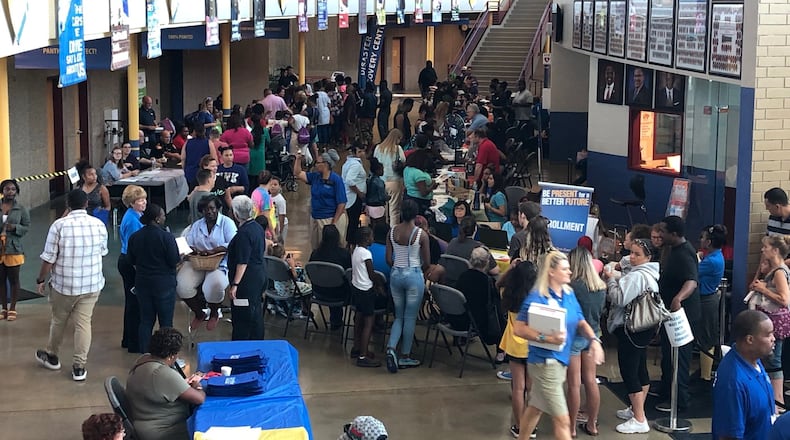RELATED: Free DPS high school busing will come in two phases
The good-attendance incentives include gas cards for parents, bike giveaways for kids, sports and movie tickets, plus parties for the classes that have the highest attendance. The district’s message to students and families is to “be present for a better future,” urging them to “strive for less than five” absences for the year.
The Path Forward project investigates solutions to the most pressing issues our community faces, including improving Dayton schools. After several years ranking at or near the bottom of the state in report-card performance, DPS has begun another attempted turnaround.
State data show that in 2017-18, the 25 highest performing school districts on state tests all had student attendance of 95 percent or higher, and all had chronic absenteeism rates below 10 percent.
The other end of the scale was the exact opposite — the 25 lowest-performing districts on tests all were below 93 percent student attendance and all had chronic absentee rates over 20 percent.
Ohio defines chronic absenteeism as missing 10 percent or more of the school year for any reason. That’s the equivalent of 17 or 18 school days, or two days a month. Dayton’s chronic absenteeism rate in 2017-18 was 30.7 percent, 15th worst of Ohio’s 608 districts. Its overall attendance rate was 90.5 percent, ninth worst.
RELATED: Five people aim to run for three school board seats
Lolli wasn’t saying that if every Dayton student showed up every single day, the district would suddenly get straight-A’s on the state report card, but she said attendance improvement would make a difference in kids’ lives.
“Whether it’s five kids or 35 kids or 50 kids, it matters for that student,” she said. “So we want to make sure that we clear the path for students and incentivize those who need to be incentivized, students and parents, and celebrate the successes of those who are already here all the time.”
RELATED: Lady Gaga funds teacher projects; policy issue keeps DPS out
Lolli and teachers union President David Romick both said one of the first steps is understanding why students miss so much school.
Dayton students and parents addressed that issue at last Sunday’s back-to-school rally. Belmont students Destiny Ayers and Alumbe Koffi both said a lack of high school busing has been an issue in recent years, especially when the weather is bad.
DPS is addressing that issue this year, investing about $4 million both to supply RTA bus passes to high schoolers and to work with RTA to launch special limited-service school routes starting Sept. 30.
Koffi also said some students have especially chaotic home lives, where parents or others are fighting all the time, sometimes through the night. Kelyea Derricks-Linder, mother of Dunbar students, said that means some kids don’t come to school because they were unable to sleep the night before.
RELATED: School sports fees can vary by as much as $1,000
Romick agreed with those reasons and added regular illnesses, as well as older students being forced to take care of younger siblings so parents can work. Lolli said DPS needs good student-to-staff communication about bullying issues that come into play, too.
“I think there are a lot of issues that affect our families, many where it’s not a matter of ‘I just don’t want to go to school today,’ “ Lolli said.
Along with the busing investment, DPS is partnering with Five Rivers Health Centers to open a student and family clinic at Roosevelt Elementary, hoping to work on health issues related to attendance.
But it goes beyond tangible projects. Lolli said there’s an angle of building motivation and competition to fix more controllable absenteeism instances. She said last year, when she made mass phone calls to all DPS families, announcing which schools had the highest attendance for certain periods, it built healthy competition. She intends to do that on a more regular basis this year.
RELATED: What do schools do when students have no lunch money?
Romick said one of the key problems with high absentee rates is that teachers have to constantly catch certain students up, while still trying to move the whole group ahead academically.
“It’s tough to maintain a lesson plan and a focus moving forward when you’ve got to always be mindful that you’re trying to catch kids up who weren’t there, and remediate them, maintain that sort of multiple focus,” he said.
Under House Bill 410, Dayton, like all school districts, has building-level attendance plans and teams. Romick said that’s important because understanding a student’s absenteeism issues may require a teacher, counselor, nurse, security officer and others to all be on the same page.
Lolli said DPS has 88 people working in committee and team fashion to work on the attendance push — some working with community partners to secure student prizes, some planning special events and some doing communication work with hard-to-reach families.
“We’re getting this out on our website, on Facebook, we’ve been doing “all-calls” and I’ll do another one about the incentives for the first quarter,” Lolli said. “Building attendance teams will talk to their parents, and we have some celebrity calls coming out telling kids to get to school.”
About the Path Forward
Our team of investigative reporters digs into what you identified as pressing issues facing our community. The Path Forward project seeks solutions to these problems by investigating how to improve Dayton Public Schools. Follow our work at DaytonDailyNews.com/PathForward or join one of our Facebook Groups.
Dayton schools attendance incentives
• Gas cards for parents
•Bike giveaways
• Sports tickets
• Movie tickets
• Class parties
About the Author

